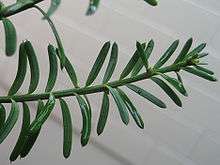Prumnopitys taxifolia
| Mataī | |
|---|---|
 | |
| Scientific classification | |
| Kingdom: | Plantae |
| Division: | Pinophyta |
| Class: | Pinopsida |
| Order: | Pinales |
| Family: | Prumnopityaceae |
| Genus: | Prumnopitys |
| Species: | P. taxifolia |
| Binomial name | |
| Prumnopitys taxifolia (Banks & Sol. ex D. Don) de Laub. | |
Prumnopitys taxifolia (mataī or black pine) is an endemic New Zealand coniferous tree that grows on the North Island and South Island. It also occurs on Stewart Island/Rakiura (47 °S) but is uncommon there.
It grows up to 40 m high, with a trunk up to 2 m diameter. The leaves are linear to sickle-shaped, 10–15 mm long and 1.5–2 mm broad. The seed cones are highly modified, reduced to a central stem 3–4 cm long bearing 1-6 scales, each scale maturing berry-like, 10–15 mm long, violet-purple with a soft edible pulp covering the single seed. The seeds are dispersed by the kererū (New Zealand pigeon), which eats the 'berries' and passes the seeds in its droppings.
Classification
The scientific name taxifolia derives from the resemblance of the leaves to those of the yew (Taxus). In the past the species, like the other species of Prumnopitys, was often included in Podocarpus; in this species under the name Podocarpus spicatus. It is distinguished from Prumnopitys ferruginea (miro) by the shorter, more slender leaves and the globose violet-purple cones.
Juvenile state

Unlike the related miro (Prumnopitys ferruginea), mataī has a distinctive and long-lasting juvenile stage. The juvenile is a shrub with a tangle of slender, flexible, divaricating branchlets interspersed with a scattering of brown, pale yellow, or dirty white leaves. After a number of years, the adult tree begins to grow out of the top of the juvenile shrub and then the divaricating branchlets will wither and drop off.
Use

The timber of this tree was used extensively in New Zealand for flooring during the mid-20th century. Mataī is not threatened, although as a forest-type it has been greatly reduced through widespread logging. Very few intact examples of mataī-dominated forest remain.
References and external links
| Wikimedia Commons has media related to Prumnopitys taxifolia. |
- Conifer Specialist Group (1998). "Prumnopitys taxifolia". IUCN Red List of Threatened Species. Version 2006. International Union for Conservation of Nature. Retrieved 12 May 2006.
- Gymnosperm Database: Prumnopitys taxifolia description
- New Zealand Plant Conservation Network, URL: Prumnopitys taxifolia. Accessed 2010-10-03.
